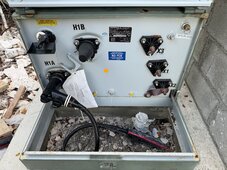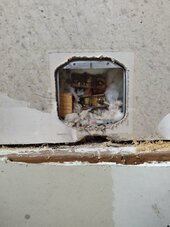Alvin1047
New Member
I am trying to understand my house wiring to know how, where, what kind of inverter to use, and for example the bonding setting on EG4 6000xp.
I have two 200 amp main panels about 4 ft apart. Each is connected L1 L2 N directly to my customer-owned step-down transformer about 100 ft from my main panels, i.e. six conductors total, no disconnects or junction boxes between the transformer and the two main breakers.
My only meter is one mile away on the other side of my step-up transformer. I.e. I take utility power at metered 240, step it up to 7,500 for a mile, and back down in the yard.
Each main panel has a ground conductor clamped to the single main foundation earth just below. No earth “rods” at the house.
Each main panel is bonded N-G as permitted and inspected in about 2012.
120 loads on either panel cause current in both panels’ ground conductors, as well as a currently empty EMT connection between the panels. The current on the ground wires spikes to about 4 amps when a 120 motor is started and settle to .5 amps or so.
Apparently, the 120v currents returning to panel 1 land on its bonded neutral bus and see a direct path to the transformer in panel 1. But they also see the ground wire leading via the ground system to panel 2’s bond to its service neutral (connected at the transformer to the neutral from panel 1. And vice versa so all neutral currents back to one panel are returned by both panels.
240 loads have no effect and 120 gfci breakers see balanced currents and do not trip, whereas the panel as a whole will always be unbalanced.
Should one of the panels be unbonded? Unbonding would cut the ground flows. It seems to me that a short circuit in any circuit on either panel would find the single bond and trip the associated breaker.
If unbonding one panel is ok, would this allow me to lockout the unbonded panel and serve it from a bonded inverter, or, as I suspect, since the neutrals are unbroken would the inverter neutral returns still see two paths, one at the bonded panel and the other at the inverter? (Meaning unbonded inverter supply required.)
I have two 200 amp main panels about 4 ft apart. Each is connected L1 L2 N directly to my customer-owned step-down transformer about 100 ft from my main panels, i.e. six conductors total, no disconnects or junction boxes between the transformer and the two main breakers.
My only meter is one mile away on the other side of my step-up transformer. I.e. I take utility power at metered 240, step it up to 7,500 for a mile, and back down in the yard.
Each main panel has a ground conductor clamped to the single main foundation earth just below. No earth “rods” at the house.
Each main panel is bonded N-G as permitted and inspected in about 2012.
120 loads on either panel cause current in both panels’ ground conductors, as well as a currently empty EMT connection between the panels. The current on the ground wires spikes to about 4 amps when a 120 motor is started and settle to .5 amps or so.
Apparently, the 120v currents returning to panel 1 land on its bonded neutral bus and see a direct path to the transformer in panel 1. But they also see the ground wire leading via the ground system to panel 2’s bond to its service neutral (connected at the transformer to the neutral from panel 1. And vice versa so all neutral currents back to one panel are returned by both panels.
240 loads have no effect and 120 gfci breakers see balanced currents and do not trip, whereas the panel as a whole will always be unbalanced.
Should one of the panels be unbonded? Unbonding would cut the ground flows. It seems to me that a short circuit in any circuit on either panel would find the single bond and trip the associated breaker.
If unbonding one panel is ok, would this allow me to lockout the unbonded panel and serve it from a bonded inverter, or, as I suspect, since the neutrals are unbroken would the inverter neutral returns still see two paths, one at the bonded panel and the other at the inverter? (Meaning unbonded inverter supply required.)




